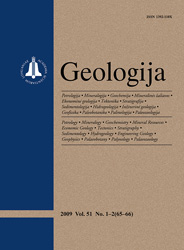Geologija / Geology
WHAT?
 ISSN 1392-110X ISSN 2029-056X (online) |
2007 m. Nr. 1 Geoecological estimation of sedimentation peculiarities
of chemical element genetic forms in some basins of
the South Baltic
This work, from the geoecological positions, presents quantitative relation data on elements formed by the interaction of natural sedimentation processes and human impact on the sediments from the study areas – the Gulf of Finland, the Gdansk Bay, Klaipėda and Gdansk ports. The total (T), lithogenic (stable – LG) and hydrogenic (mobile, reaction capable – HG) migration (state) forms of Zn, Cr, Cd, Cu, Pb, Ni, etc. were analysed. Among the latter genetic forms, ionic exchange (IE), organic–mineral (OM) and hydroxidic (HO) species were analysed as different but most reaction-capable forms. All these forms reflect the regularities of different course of sedimentation processes during the last 10 (and more) thousand years in the history of the Baltic Sea possibly affected by anthropogenic influence in the last two centuries. A detailed analysis of these forms in the stratum of bottom deposits has revealed that the distribution of elements and formation of their anomalous quantities in the Gdansk Bay and the Gulf of Finland were determined by natural processes: geological structure, rock composition, peculiarities of geochemical barrier zones, changes of hydrological conditions. During the many-sided investigation of Klaipėda and Gdansk port sediments, the areas of natural (NSZ) and technogenic (TSZ) sedimentation zones were distinguished. Anomalous quantities of elements, specific distribution of their migration forms, hemistagnation conditions and the nearness of technogenical sources are typical of the latter zone. The quantities of elements in the NSZ of marine influence are smaller than those in both sedimentation zones of the river part of the Gdansk Port. The balance of HG, LG and T forms in the port sediments of both zones is different for the various elements, but in the TSZ it is always greater than in the NTZ. The distribution of T form depends on the quantity of fraction <0.063 mm and on the concentration of Corg. Going deeper into the sediments, their quantities sharply decreased, but the part of HG form evidently increased. Their presence after mineralisation and destruction of sedimentary matter can be explained only by their concentration in the remnants of biological activity. The data presented in this work indicate that some geochemical anomalies in the TSZ of both ports and in the Sea Basin only in rare cases exceeded the maximum permissible concentrations (MPCs) for the dredged and dumped material and for the biological conditions. This is not enough to prove the popular conception of global pollution. To determine the more actual (toxic) level of pollution, more detailed investigations of element state forms (especially their HG species) are necessary. The analysis of element forms indicates the necessity of adjusting the existing MPCs. Keywords: migration forms, sedimentation zones, elements distribution, the Baltic Sea |
Issues:
2011 - Vol.53 No. 1, No. 2, No. 3 2010 - Vol.52 No. 1-4 2009 - Vol.51 No. 1-2, No. 3-4 2008 - Vol.50 No. 1, No. 2, No. 3, No. 4, No. Priedas 2007 No. 1, No. 2, No. 3, No. 4 2006 No. 1, No. 2, No. 3, No. 4 2005 No. 1, No. 2, No. 3, No. 4 2004 No. 1, No. 2, No. 3, No. 4 2003 No. 1, No. 2, No. 3, No. 4 2002 No. 1, No. 2, No. 3, No. 4 2001 No. 1, No. 2, No. 3, No. 4 |